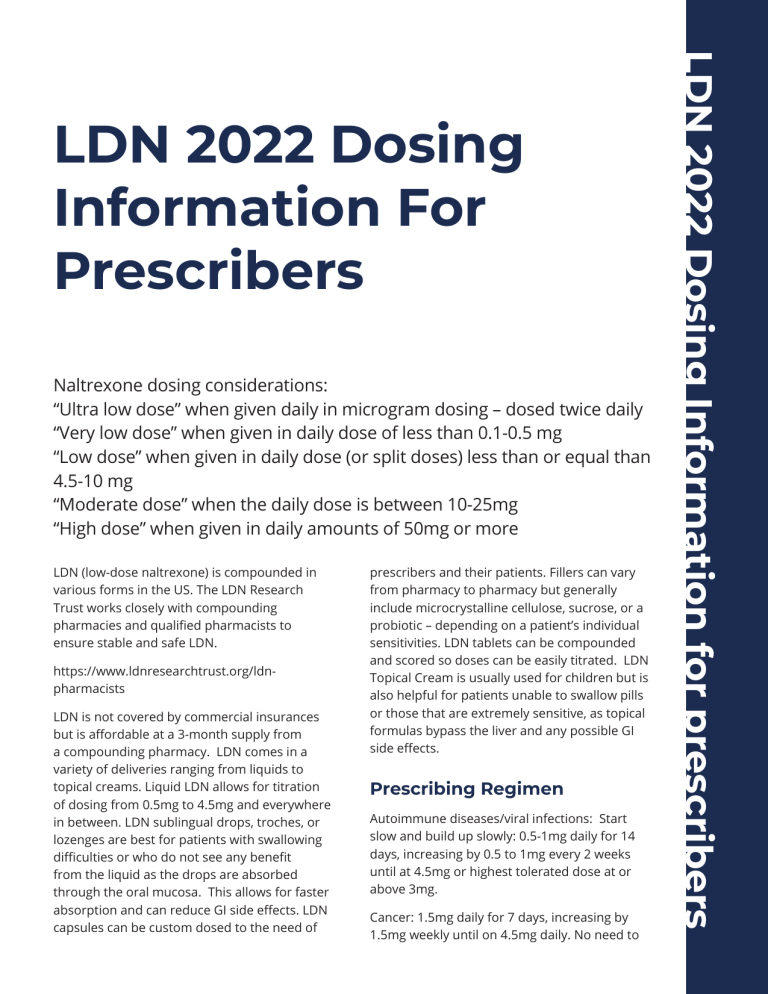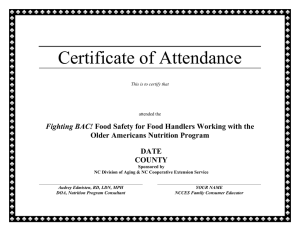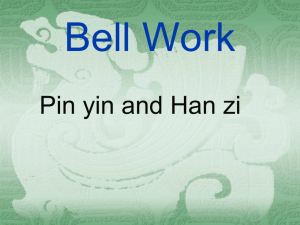
Naltrexone dosing considerations: “Ultra low dose” when given daily in microgram dosing – dosed twice daily “Very low dose” when given in daily dose of less than 0.1-0.5 mg “Low dose” when given in daily dose (or split doses) less than or equal than 4.5-10 mg “Moderate dose” when the daily dose is between 10-25mg “High dose” when given in daily amounts of 50mg or more LDN (low-dose naltrexone) is compounded in various forms in the US. The LDN Research Trust works closely with compounding pharmacies and qualified pharmacists to ensure stable and safe LDN. https://www.ldnresearchtrust.org/ldnpharmacists LDN is not covered by commercial insurances but is affordable at a 3-month supply from a compounding pharmacy. LDN comes in a variety of deliveries ranging from liquids to topical creams. Liquid LDN allows for titration of dosing from 0.5mg to 4.5mg and everywhere in between. LDN sublingual drops, troches, or lozenges are best for patients with swallowing difficulties or who do not see any benefit from the liquid as the drops are absorbed through the oral mucosa. This allows for faster absorption and can reduce GI side effects. LDN capsules can be custom dosed to the need of prescribers and their patients. Fillers can vary from pharmacy to pharmacy but generally include microcrystalline cellulose, sucrose, or a probiotic – depending on a patient’s individual sensitivities. LDN tablets can be compounded and scored so doses can be easily titrated. LDN Topical Cream is usually used for children but is also helpful for patients unable to swallow pills or those that are extremely sensitive, as topical formulas bypass the liver and any possible GI side effects. Prescribing Regimen Autoimmune diseases/viral infections: Start slow and build up slowly: 0.5-1mg daily for 14 days, increasing by 0.5 to 1mg every 2 weeks until at 4.5mg or highest tolerated dose at or above 3mg. Cancer: 1.5mg daily for 7 days, increasing by 1.5mg weekly until on 4.5mg daily. No need to LDN 2022 Dosing Information for prescribers LDN 2022 Dosing Information For Prescribers LDN 2022 Dosing Information for prescribers take days off or cycle dosing of LDN. Chronic Pain: Start slow and build up slowly: 1mg daily for 14 days, increasing by 0.5 to 1mg every 2 weeks until at 4.5mg or highest tolerated dose at or above 3mg. May need to split dose to twice daily dosing, at maximum 9-10mg daily for best response, especially if there is difficulty absorbing nutrients/ medications or if larger body weight. Fertility/Pregnancy: Start slow and build up slowly: 1mg daily for 14 days, increasing by 0.5 to 1mg every 2 weeks until at 4.5mg or highest tolerated dose at or above 3mg. PTSD/Anxiety/Depression: Most mental health patients respond well to multiple doses of 0.06 mg/kg/body weight, about 3 to 6 mg each dose, and many notice no benefit until they reach the 0.06 mg dose level. LDN must be used strategically in a manner that disrupts and suppresses the opioid system-based dissociation underlying these disorders. This disruption/suppression depends on maintaining a relatively constant serum blood level of LDN, which may require up to 2-3 doses taken during waking hours. The majority of mental health patients can tolerate starting at the full 0.06 mg dose ratio, but it is better to start at half that dose to minimize the possibility of negative side effects. Once a lower dose is well tolerated, the dose can usually be increased rapidly to the 0.06 mg dose range, taking a few days to a couple weeks. If there is a diagnosis of Dissociative Identity Disorder (DID – see pages 159-160 in “The LDN Book Two”), recent opiate addiction, or a known history of severe early neglect and abuse, one should provide psycho-education and proceed with more caution. TBI: Recent acute TBI injuries will likely require aggressive treatment with higher doses of naltrexone (>50 mg) for several months or until symptoms improve, followed by a low dose regimen. In some cases, a transdermal application of LDN applied to the carotid artery with the patient lying down to increase the concentration of naltrexone delivered to the brain will be adequate. TBI in an advanced stage of recovery or mid concussions may be treated with the standard MH protocol. Children: Children under 40kg 0.1 mg/kg start at 0.1mg and increase over a period of 4 weeks to calculated dose. Creams have little evidence of efficacy but are available for topical administration. Children >40kg—treat as an adult. In children take special care that the status as an unlicensed medicine is well known by family members. Pets: Doses of up to 15mg daily have been used in dogs. Time of day: Same time every day; day or night is irrelevant. Discuss specific cases with veterinary compounder familiar with LDN dosing in pets. Ultra Low Dose Naltrexone is generally dosed at 1μg (microgram) twice daily, while monitoring for greater opiate medication response, and thus the ability to lower the opiate medication dose. Opiate Weaning: The recommended dose of Ultra-Low Dose Naltrexone (ULDN) is 1 μg twice daily. The general recommendation for opiate weaning is to taper by 10% monthly if a patient has been taking opiate medications longer than a year. A more aggressive weaning may be considered for a relatively opiate naïve patient (use not longer than weeks to months), such as decreasing by 10% weekly or more – as quickly as 5 weeks overall. This is a general approach and must be individualized to each patient. This must be done with a multidisciplinary approach utilizing primary care, pain management and other specialists to determine the appropriate treatment plan and closely monitor for adverse effects and need for greater support. References: 1. Toljan K, Vrooman B. LowDose Naltrexone (LDN)-Review of Therapeutic Utilization. Med Sci (Basel). 2018 Sep 21; 6(4). Epub 2018 Sep 21. 2. Liptan, G. The FibroManual: A Complete Fibromyalgia Treatment Guide for You and Your Doctor. New York, Ballantine Books, 2016. Drug Compatibility Biologics: compatible as long as being monitored and stable before LDN initiation with Daclizumab (Zinbryta), Dimethyl fumarate (Tecfidera) Fingolimod (Gilenya), Interferon beta-1a (Avonex, Rebif) Mitoxantrone (Novantrone), Natalizumab (Tysabri) Ocrelizumab (Ocrevus), Peginterferon beta-1a (Plegridy) Teriflunomide (Aubagio), Glatiramer acetate (Copaxone, Glatopa) Interferon beta-1b (Betaseron, Extavia), Tetracyclines, Aminoglycosides, Compatible with caveats. Steroids: (Prednisone/Methylprednisolone) as long as the daily dose is <20mg equivalent prednisolone and not being used for organ replacement anti-rejection therapy. Dexamethasone at any dose as long as it is being monitored by oncology. All other prescription only medications and prescription medicines depending on patient disease state and general clinical patient stability. Short acting painkillers like cocodamol/tramadol leave 4-6 hour gap before LDN. Use with caution Ketamine, Patients on active clinical trials and Anti–Tumour Necrosis Factor not compatible. Not compatible with: SR Morphines or analogs: MST, OXYCONTIN, DIPIPANONE, and FENTANYL Anti rejection drugs, Anti– Tumour Necrosis Factor, PD1 inhibitors (Opdivo and Keytruda and all in class) Anti cancer vaccines—CAR-T and equivalent plus all in class. Patient Inclusion Criteria Does the patient have a disease listed on the LDN Research Trust website as currently being treated, or is their disease autoimmune in nature? No blood tests, LFT or renal function tests are routinely required due to the low dose prescribed. Patient Exclusion Criteria Concomitant opiate administration increases risk of induced withdrawal. Contraindicated in sustained release opiates or high doses. Switch to alternative pain control and/or leave 4-6 hour gap between opiate and LDN. Cautionary use with short acting opiates. Caution with alcohol and tramadol (Ultram). Patient Special Considerations Hashimotos thyroiditis patients may require closer titration and testing of T3/T4 levels every 4-8 weeks during initiation phase. CFS/ME patients often experience flu like symptoms and may need slower titration. If exacerbation of symptoms, decrease dose until able to tolerate titrate accordingly. MS patients often experience worsening of MS symptoms in the first 8 weeks. This is normal and is often a sign of good long-term response. LYME patients on multiple antibiotics and DMARD agents should seek careful advice from and work with experienced providers and pharmacists before initiating LDN. https://www.ncbi.nlm.nih.gov/pmc/articles/ PMC6313374/ Disclaimer: The information is designed as a guide, each patient is unique as is their treatment plan. UK: 01223 926 933 US: (847) 794 8046 Email: linda@ldnresearchtrust.org Registered Charity Number: 1106636 Compiled by: Dr. Sarah Zielsdorf MD, MS. Medical Director of the LDN Research Trust LDN 2022 Dosing Information for prescribers 3. Leavitt SB. Opioid Antagonists in Pain Management. Practical Pain Management. 9 Articles in Vol 9, Issue #3.





